How do you co-ordinate a £1bn budget, 40 buildings, 22 architects and 90 consultants to deliver the most ambitious regeneration scheme Liverpool has ever seen? Thomas Lane went to ask the man who has to do it
With less than five months to go before the completion of Liverpool’s most significant regeneration project ever, the man responsible for its delivery is feeling the pressure. “We aren’t doing this because we’re masochists, although it feels like it sometimes,” says Rod Holmes, retail projects director Grosvenor.
Given the heat he is subjected to, Holmes can be forgiven for sweating a little. As Grosvenor’s retail projects director he is overseeing a £1bn project to construct a 17 ha city quarter on and around Paradise Street. This scheme is challenging because of its scale and grandiose ambition, but these are amplified by events beyond the developer’s control, such as Liverpool being declared Europe’s Capital of Culture for 2008 and the rise in construction costs.
The Paradise Project is crucial to the successful regeneration of Liverpool’s city centre, which has lost retail traffic to other regional cities and out-of-town malls. “One way to fight back was to create as much variety, choice and surprise as possible,” says Holmes. Rather than keeping things simple and employing one architect to design a straightforward mall, he opted to introduce variety and surprise by constructing 40 buildings, including shops, apartments and offices, and appointing a squad of 22 architectural practices to design them. These include Glenn Howells, CZWG and Austin-Smith:Lord.
And the architects are just the visible bit of this enormous iceberg. Ninety other consultant firms are involved in the project, which means that co-ordinating the individuals who make up the project teams is “hugely complex”, in the words of Richard Taylor, partner in Davis Langdon, which is the cost consultant on the project. “It’s by far the hardest thing I’ve worked on.”
The fact that Liverpool is Capital of Culture this year has added to the pressure, as completion was brought forward from 2009 to 2008. “The city becoming the capital of culture was an impetus to open as much as possible in 2008, as retailers want to benefit from the extra footfall,” says Holmes.
Money has been a worry, too. “We have always been under pressure to move it forward financially,” he says. “Another big problem has been getting contractors to accept risk and to get them to procure trade packages competitively.”
The only way to keep up with the demanding programme was to design the scheme as it was being built, using a two-stage tendering process. The architects were asked to produce concept designs and these were used to obtain outline planning permission. Responsibility for detailed design has been handed over to the contractors.
It’s hugely complex. It’s by far the hardest thing I’ve worked on
Richard Taylor, partner, Davis Langdon
In August 2003, quite early in the process, Laing O’Rourke was selected as delivery partner for the scheme. Grosvenor then opted to reinforce it with other contractors, including Kier and Balfour Beatty. The bulk of the project was split between Laing O’Rourke and Balfour Beatty, which spread the risk but kept things simple. “Like any large project, it breaks down into a number of parts and can go horribly wrong at the interfaces,” says Bill Allen, Grosvenor’s technical director. “To have put it into one hand would have been too much.”
Balfour Beatty is responsible for £110m of work to the east of Paradise Street and Laing O’Rourke is looking after the £400m west side. They have both taken responsibility for working the concepts into detailed designs. In some cases this is being done by the original architects, but most is being done by architect Building Design Partnership, which was also responsible for the masterplan.
Once the detailed designs of elements are completed, they are being tendered out to specialist contractors. Grosvenor, Davis Langdon and the contractor choose the successful subcontractor, with Grosvenor bearing the financial risk of the two-stage process.
Unfortunately, Grosvenor has suffered from tender price inflation, which Davis Langdon’s Taylor says has been running at 6% a year for the past two years. Ironically, this inflation has partially been fuelled by the demand created by the Paradise Project. “It’s created its own mini inflationary environment, owing to the boom in north-west England. This area has a much higher rate of inflation than when we started out,” says Grosvenor’s Allen.
Both main contractors have used their in-house supply chains where possible.
Balfour Beatty used Stent for the piling and Balfour Fitzpatrick for M&E work. Laing O’Rourke used Expanded for piling and insitu concrete frame elements, Malling for precast elements and Crown House for M&E. Both contractors say this has been a fair and advantageous process. “Our internal companies have had to compete to get on board,” says Gerry Whyte, Laing O’Rourke’s project leader for retail. “It has given us a much greater degree of control over our own destiny.”
Despite this, Grosvenor feels it has taken more than its fair share of risk. “Grosvenor has taken far more construction and cost risk on this project than we envisaged, and should have been necessary,” says Holmes. “We tried to offer contractors the opportunity to take contracts on a pain and gain basis, but this hasn’t worked. The contractors are in a bull market at the moment and didn’t feel they needed to take additional risk.”
Like any large project, it breaks down into a number of parts and can go horribly wrong at the interfaces
Bill Allen, Grosvenor
These rising costs forced Grosvenor to warn that it had spent £140m more than originally envisaged in April. Part of this is attributable to the hit it took on the land assembly costs – like the rising construction costs Grosvenor created its own mini-boom, which pushed up land values during the acquisitions.
The developer is now looking at ways of saving money. “We’ve had to redesign, take out scope and look at alternative ways of procuring,” says Allen. For example, a Glenn Howells-designed pavilion in a park in the middle of the development will not be built immediately. Value-engineering is also playing an important role in containing costs. “We looked at each site forensically to see what we could trim,” says Allen. “We couldn’t do wholesale surgery as we had to deliver against the masterplan.”
For their part the contractors are keen to demonstrate how they are keeping costs down. “We’ve had a fairly significant role in this, through value-engineering sessions with Grosvenor,” says Whyte, adding that virtually every element of the scheme has been examined to find ways of saving money. He cites the example of a canopy that protects people from the weather as they walk down a colonnade. The price for the glass support structure on top of the columns would have been very high but Laing O’Rourke got the components made in China.
Alan Henshaw, Balfour’s project director, has a similar story. “We’ve spent a lot of time trying to get best value as aluminium and glass prices have gone through the roof,” he says. An example of value-engineering was a 10-storey residential building located between Paradise Street and College Lane. Originally this had glass windows, with expensive aluminium spandrel panels used for the solid areas. The solution was to use glass for the whole facade with a frit coloured to match anodised aluminium where the aluminium panels were originally to go. The colour matching took nine months.
Despite these pressures, Holmes says things are going very well. He stresses that relationships with contractors are good at site level and that construction is proceeding at an “extraordinary rate”. He says the project is on track for a million square feet of retail to be ready this year.
Some buildings are finished and open, while others are nearing completion. For example, two anchor stores, Debenhams and John Lewis, were handed over by Laing O’Rourke earlier this year for fit-out.
The fit-out phase worries Holmes because it means many more different teams on site, which will be a “huge logistical challenge”.
He is also concerned about achieving high-quality finishes. “It’s easy pouring concrete for groundworks but finishing buildings to a high quality is always challenging.” It looks like Holmes won’t be able to relax quite yet.
Project team
Client Grosvenor Estates
Masterplanner Building Design Partnership
Urban design consultant Pelli Clarke Pelli
Structural and environmental engineer Waterman Partnership
Infrastructure and services engineer WSP Group
Cost consultant Davis Langdon
Contractor (west of Paradise Street) Laing O’Rourke
Contractor (east of Paradise Street) Balfour Beatty
Contractor (Hilton hotel) Kier
How a lack of competition leads to spiralling costs
After having to find an extra £140m to finish his project, Grosvenor’s Rod Holmes is understandably unhappy. He believes the industry suffers from what he describes as “structural problems” when it comes to procurement – and by this he means designers as well as contractors. “As clients we want real competition between specialists, but it is very difficult to do that as you can’t complete the design and get a price until the specialists are on board,” he says. “It’s a chicken-and-egg situation.”
Holmes says the industry’s panacea is co-operative forms of working such as partnering, which is a procurement route he has little time for. “When it comes to delivery in virtually every other sector, such as health or education, people expect competition. Bizarrely, in construction we don’t get this.
“We have to get back to the situation where general constructors and specialists can secure work and make good returns by being creative and efficient technically and commercially on well managed sites.”
This is what a bomb looks like … how Paradise Street was built
Virtually the whole site was derelict before Grosvenor took it over. Some of it was bomb damaged and much of the rest was occupied by car parks, along with warehouses, derelict listed buildings and a hotel full of old mattresses that were classified as hazardous waste. There were some occupied buildings, including a BBC office, a hairdressers and a bus station. These three organisations had to be accommodated, and all the parking spaces had to be retained.
Laing O’Rourke started work on site in October 2004. “The first thing that happened was the bus station had to be relocated to the south,” explains Gerry Whyte, the firm’s project leader. “That had to happen quickly, as we couldn’t start work on the retail elements until it was complete.”
Next, the existing tenants had to be relocated to new buildings. Getting rid of the old car parking proved more problematic than first envisaged. “A lot of remedial work had been carried out on it over the years so it wasn’t very stable,” says Whyte. “We didn’t know how it would react to demolition works, so with the demolition contractor DSM we decided to blow it down.”
A large part of the west side of the site was built over a massive basement containing car parks and service yards. Whyte says every single pile had to be probed for unexploded bombs from the war. “Everyone was inducted as to what a bomb looks like,” he says.
Off-site techniques have helped the team keep up with the demanding programme. Laing O’Rourke used its subsidiary, Malling, to produce precast frame elements such as beams and twin walls. These are pre-cast structural wall sections, with a void in the centre into which concrete is poured for maximum strength. This cuts out the need for formwork.
Balfour Beatty started later, in the middle of 2005, and has adopted an almost identical approach to structural construction. Laing O’Rourke had the advantage of Expanded, its own in-house frame specialist, so Balfour Beatty partnered with Heyrod Construction, north-west England’s largest concrete frame specialist.
Balfour Beatty’s very tight site has been challenging. It has brought in 10 tower cranes to ease the movement of materials, but Alan Henshaw, Balfour’s project director, says even this was not enough. “We couldn’t fit any more on the site,” he says. “Then there weren’t enough hours in the day, so the cranes have been working at full capacity including at nights and weekends.” He says that bad summer weather has not helped, nor has the fact that one very tall crane oversails six others. “It has been managed very carefully with lots of banksmen, but even so its potential is significantly reduced,” Henshaw says.
Another tightly-congested area is the drains. “We’ve had to slot new drains under the road, which is a minefield of existing services,” says Henshaw. He says mining under them, rather than digging up the road, was the answer. “It was the quickest way of doing it,” he says. “It’s much easier than trying to liaise with all the utilities.”
Both contractors say the worst bits are over. Whyte is confident about completing the Laing O’Rourke retail elements by March. “It’s all on schedule, I can say hand-on-heart.”
Meanwhile, Balfour Beatty is beginning to take tower cranes down, a moment described by Henshaw as “significant”. A million square feet of the site will open in May with the eastern half of the site opening later in the year in September.
Downloads
Whodunnit?
Other, Size 0 kb
The Liverpool Issue

- 1
- 2
- 3
- 4
 Currently
reading
Currently
reading
Liverpool One on-site: Welcome to paradise
- 6
- 7
- 8
- 9
- 10






























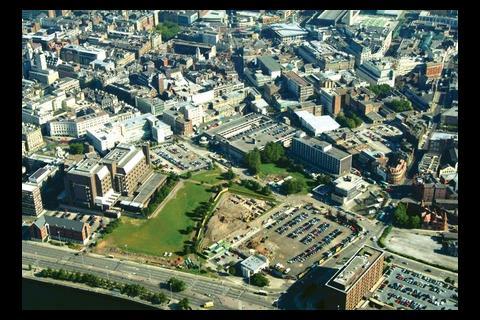

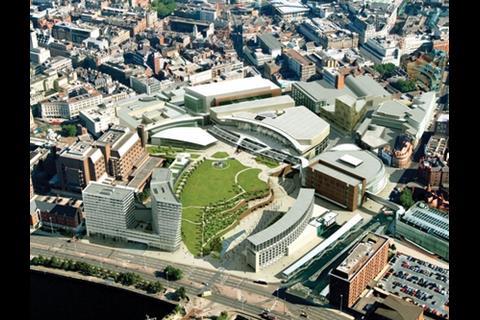


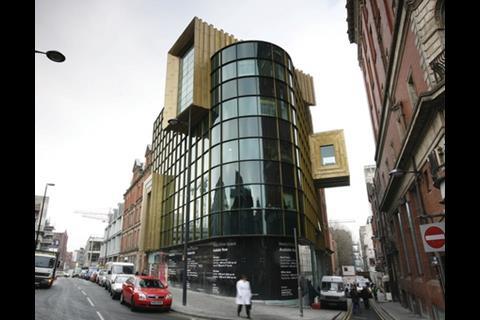
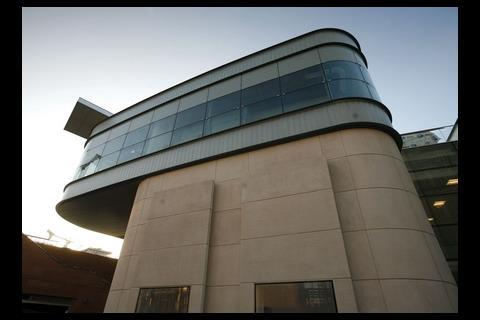
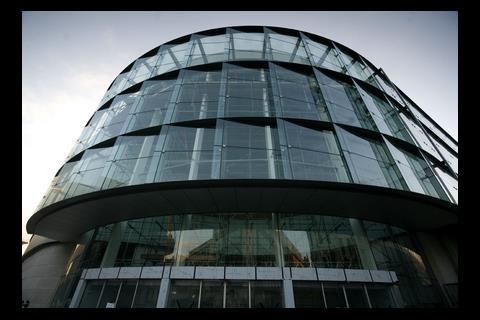


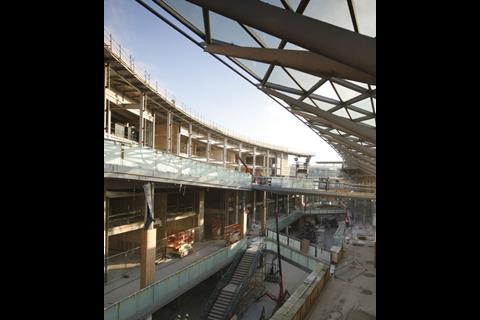














No comments yet